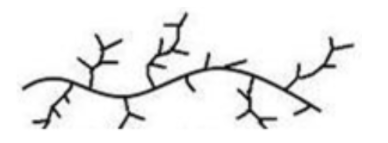
The difference in the density of low density polymers (LDP) and high density polymers (HDP) is due to the fact that:
A. LDP are highly branched structures while HDP consists of closely packed linear molecules.
B. LDP are linear chains while HDP are branched chains of polythene.
C. Both LDP and HDP are unbranched linear chains with different lengths.
D. At high temperature, the density of polymer is reduced.
Answer
133.5k+ views
Hint: Polymers are chemical compounds with high molecular weight and made up of repeated units called monomers. These units can be the same or different. On the basis of the nature of monomers a polymer can be homo or copolymer.
Complete step by step answer:
LDPE and HDPE are thermoplastic polymers. Polymers are high molecular mass compounds whose structures are composed of a large number of simple repeating units. The repeating structural units are usually obtained from low molecular mass of simple compounds called monomers.
(i) Low density polythene (LDPE): It is prepared by heating pure ethylene at $190^\circ - 210^\circ C$ under a pressure of about $1500$atmosphere in the presence of traces of oxygen. The polymer produced consists of highly branched chain molecules. The branching does not allow the polymer molecules to undergo close packing and thus, the density of polymer is low and it has low melting point.
$\mathop {nC{H_2} = C{H_2}}\limits_{ethene} \xrightarrow[{\left( {oxygen} \right)}]{{200^\circ C,{\text{ 1500 atm}}}}\mathop {{{\left[ { - {H_2}C - C{H_2} - } \right]}_n}}\limits_{\left( {polyethene} \right)} $
Low density polythene can be represented as,

It is chemically inert, tough but flexible. It is a poor electrical conductor. It is used for packaging, cable insulation and in the manufacture of pipes, squeeze bottles and toys.
High density polythene (HDPE): It is manufactured by coordination polymerisation of ethylene in a hydrocarbon solvent at $60^\circ - 70^\circ C$under a pressure of$6 - 7$atmosphere in the presence of a catalyst such as triethyl aluminium and titanium tetra chloride.
\[nC{H_2} = C{H_2}\xrightarrow[{TiC{l_4} + Al{{\left( {{C_2}{H_5}} \right)}_3}}]{{60^\circ - 70^\circ C,{\text{ 6atom}}}}\mathop {{{\left[ { - C{H_2} - C{H_2} - } \right]}_n}}\limits_{\left( {polyethene} \right)} \]
The structure of HDPE can be represented as,

The polymer thus produced, consists of practically linear molecules which are closely packed and have high density.
It is chemically inert but tough and harder. Its tensile strength is more than that of low density polymers. It is used in making housewares such as buckets, dustbin, bottle, pipes, toys, etc.
Hence, the correct option is (A).
Note:
In general high density grade polythene have densities up to $0.97g/c{m^3}$and low density grade polythene have density as low as $0.91g/c{m^3}$. High density material is more linear and crystalline. Low density polythene has less stiffness than the high density polythene.
Complete step by step answer:
LDPE and HDPE are thermoplastic polymers. Polymers are high molecular mass compounds whose structures are composed of a large number of simple repeating units. The repeating structural units are usually obtained from low molecular mass of simple compounds called monomers.
(i) Low density polythene (LDPE): It is prepared by heating pure ethylene at $190^\circ - 210^\circ C$ under a pressure of about $1500$atmosphere in the presence of traces of oxygen. The polymer produced consists of highly branched chain molecules. The branching does not allow the polymer molecules to undergo close packing and thus, the density of polymer is low and it has low melting point.
$\mathop {nC{H_2} = C{H_2}}\limits_{ethene} \xrightarrow[{\left( {oxygen} \right)}]{{200^\circ C,{\text{ 1500 atm}}}}\mathop {{{\left[ { - {H_2}C - C{H_2} - } \right]}_n}}\limits_{\left( {polyethene} \right)} $
Low density polythene can be represented as,

It is chemically inert, tough but flexible. It is a poor electrical conductor. It is used for packaging, cable insulation and in the manufacture of pipes, squeeze bottles and toys.
High density polythene (HDPE): It is manufactured by coordination polymerisation of ethylene in a hydrocarbon solvent at $60^\circ - 70^\circ C$under a pressure of$6 - 7$atmosphere in the presence of a catalyst such as triethyl aluminium and titanium tetra chloride.
\[nC{H_2} = C{H_2}\xrightarrow[{TiC{l_4} + Al{{\left( {{C_2}{H_5}} \right)}_3}}]{{60^\circ - 70^\circ C,{\text{ 6atom}}}}\mathop {{{\left[ { - C{H_2} - C{H_2} - } \right]}_n}}\limits_{\left( {polyethene} \right)} \]
The structure of HDPE can be represented as,

The polymer thus produced, consists of practically linear molecules which are closely packed and have high density.
It is chemically inert but tough and harder. Its tensile strength is more than that of low density polymers. It is used in making housewares such as buckets, dustbin, bottle, pipes, toys, etc.
Hence, the correct option is (A).
Note:
In general high density grade polythene have densities up to $0.97g/c{m^3}$and low density grade polythene have density as low as $0.91g/c{m^3}$. High density material is more linear and crystalline. Low density polythene has less stiffness than the high density polythene.
Recently Updated Pages
JEE Main 2025 Session 2 Form Correction (Closed) – What Can Be Edited

Sign up for JEE Main 2025 Live Classes - Vedantu

JEE Main Books 2023-24: Best JEE Main Books for Physics, Chemistry and Maths

JEE Main 2023 April 13 Shift 1 Question Paper with Answer Key

JEE Main 2023 April 11 Shift 2 Question Paper with Answer Key

JEE Main 2023 April 10 Shift 2 Question Paper with Answer Key

Trending doubts
JEE Main 2025 Session 2: Application Form (Out), Exam Dates (Released), Eligibility, & More

JEE Main 2025: Conversion of Galvanometer Into Ammeter And Voltmeter in Physics

JEE Main 2025: Derivation of Equation of Trajectory in Physics

Electric Field Due to Uniformly Charged Ring for JEE Main 2025 - Formula and Derivation

Current Loop as Magnetic Dipole and Its Derivation for JEE

Inertial and Non-Inertial Frame of Reference - JEE Important Topic

Other Pages
NCERT Solutions for Class 11 Chemistry Chapter 9 Hydrocarbons

JEE Advanced Marks vs Ranks 2025: Understanding Category-wise Qualifying Marks and Previous Year Cut-offs

NCERT Solutions for Class 11 Chemistry Chapter 5 Thermodynamics

Hydrocarbons Class 11 Notes: CBSE Chemistry Chapter 9

NCERT Solutions for Class 11 Chemistry Chapter 7 Redox Reaction

Thermodynamics Class 11 Notes: CBSE Chapter 5




